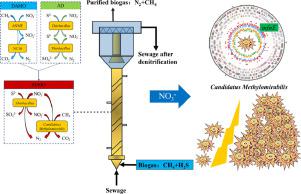Water Research ( IF 11.4 ) Pub Date : 2022-07-27 , DOI: 10.1016/j.watres.2022.118909 Wei Wang 1 , Lei Zhao 1 , Bing-Jie Ni 2 , Tian-Ming Yin 1 , Ruo-Chen Zhang 3 , Miao Yu 1 , Bo Shao 1 , Xi-Jun Xu 1 , De-Feng Xing 1 , Duu-Jong Lee 4 , Nan-Qi Ren 5 , Chuan Chen 1

|
Microbial denitrification is a crucial biological process for the treatment of nitrogen-polluted water. Traditional denitrification process consumes external organic carbon leading to an increase in treatment costs. We developed a novel sulfide-driven denitrification methane oxidation (SDMO) system that integrates autotrophic denitrification (AD) and denitrification anaerobic methane oxidation (DAMO) for cost-effective denitrification and biogas utilization in situ. Two SDMO systems were operated for 735 days, with nitrate and nitrite serving as electron acceptors, to explore the performance of sewage denitrification and characterize metabolic mechanisms. Results showed SDMO system could reach as high as 100% efficiency of nitrogen removal and biogas desulfurization without an external carbon source when HRT was 10 days and inflow nitrogen concentrations were 50–100 mgN·L−1. Besides, nitrate was a preferable electron acceptor for SDMO system. Biogas not only enhanced nitrogen removal but also intensified the DAMO, nitrogen removed through DAMO contribution doubled as original period from 2.9 mgN·(L·d)−1 to 6.2 mgN·(L·d)−1, and the ratio of nitrate removal through AD to DAMO was 1.2:1 with nitrate as electron acceptor. While nitrogen removed almost all through AD contribution and DAMO was weaken as before, the ratio of nitrate removal through AD to DAMO was 21.2:1 with nitrite as electron acceptor. Biogas introduced into SDMO system with nitrate inspired the growth of DAMO bacteria Candidatus Methylomirabilis from 0.3% to 19.6% and motivated its potentiality to remove nitrate without ANME archaea participation accompanying with gene mfnE upregulating ∼100 times. According to the reconstructed genome from binning analysis, the dramatically upregulated gene mfnE was derived from Candidatus Methylomirabilis, which may represent a novel metabolism pathway for DAMO bacteria to replace the role of archaea for nitrate reduction.
中文翻译:

一种新型硫化物驱动的反硝化甲烷氧化(SDMO)系统:运行性能和代谢机制
微生物反硝化是处理氮污染水的关键生物过程。传统的反硝化工艺消耗外部有机碳,导致处理成本增加。我们开发了一种新型硫化物驱动的反硝化甲烷氧化 (SDMO) 系统,该系统集成了自养反硝化 (AD) 和反硝化厌氧甲烷氧化 (DAMO),以实现具有成本效益的反硝化和沼气原位利用. 两个 SDMO 系统运行 735 天,硝酸盐和亚硝酸盐作为电子受体,以探索污水反硝化的性能并表征代谢机制。结果表明,当HRT为10天,进水氮浓度为50-100 mgN·L -1时,SDMO系统无需外加碳源即可达到100%的脱氮和沼气脱硫效率。此外,硝酸盐是SDMO体系的优选电子受体。沼气不仅增强了脱氮作用,而且强化了 DAMO,通过 DAMO 贡献的脱氮量翻了一番,从 2.9 mgN·(L·d) -1增加到 6.2 mgN·(L·d) -1, 硝酸盐通过 AD 与 DAMO 去除的比例为 1.2:1,硝酸盐为电子受体。虽然氮几乎全部通过 AD 贡献去除并且 DAMO 像以前一样减弱,但通过 AD 去除硝酸盐与 DAMO 的比率为 21.2:1,亚硝酸盐作为电子受体。将沼气与硝酸盐一起引入 SDMO 系统促进了 DAMO 细菌Candidatus Methylomirabilis从 0.3% 到 19.6% 的生长,并激发了其在没有 ANME 古细菌参与的情况下去除硝酸盐的潜力,同时基因mfnE上调 100 倍。根据分箱分析重建的基因组,显着上调的基因mfnE来自Candidatus Methylomirabilis, 这可能代表了 DAMO 细菌替代古细菌对硝酸盐还原作用的新代谢途径。











































 京公网安备 11010802027423号
京公网安备 11010802027423号